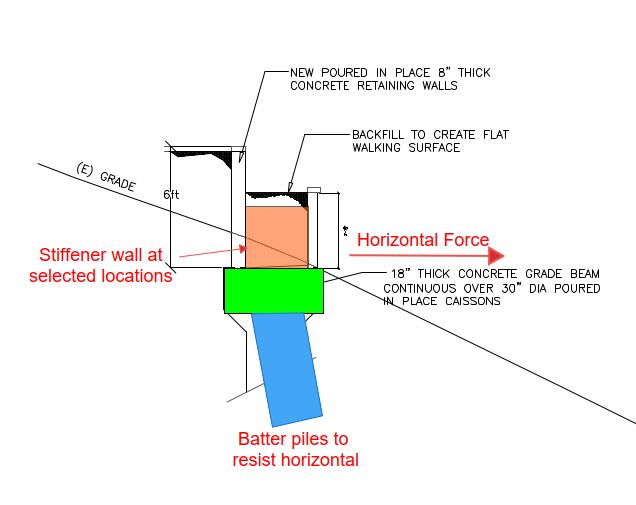I have been hired to design the retaining wall system for a hillside residence. Basically the owners house sits about 20ft behind the top of a 2 horizontal to 1 vertical slope with a height of 20ft.
They want to extend the backyard to just beyond the downslope location in addition to a zig zag set of retaining walls.
A soils report was provided to me and in order to achieve the required daylight and support the new retaining wall foundation into competent soil I am utilizing a grade beam and caisson system.
I have come up with what I believe is a good design but it is a little different then what I typically design. Since both walls are relatively closely spaced the grade beam is 4'-4" wide x 18" thick in order to support both walls.
To account for the torsion, I am designing for the full 6ft retained up slope as well as the weight of the shorter wall on the opposite end of the G.B., and the weight of the backfill between walls and weight of walls also contribute to the G.B. in bending.
I am not accounting for the soil in between the walls with respect to additional torsion from the front wall.
Just curious to your guys thoughts. Would you consider additional torsion?
Thanks
They want to extend the backyard to just beyond the downslope location in addition to a zig zag set of retaining walls.
A soils report was provided to me and in order to achieve the required daylight and support the new retaining wall foundation into competent soil I am utilizing a grade beam and caisson system.
I have come up with what I believe is a good design but it is a little different then what I typically design. Since both walls are relatively closely spaced the grade beam is 4'-4" wide x 18" thick in order to support both walls.
To account for the torsion, I am designing for the full 6ft retained up slope as well as the weight of the shorter wall on the opposite end of the G.B., and the weight of the backfill between walls and weight of walls also contribute to the G.B. in bending.
I am not accounting for the soil in between the walls with respect to additional torsion from the front wall.
Just curious to your guys thoughts. Would you consider additional torsion?
Thanks

